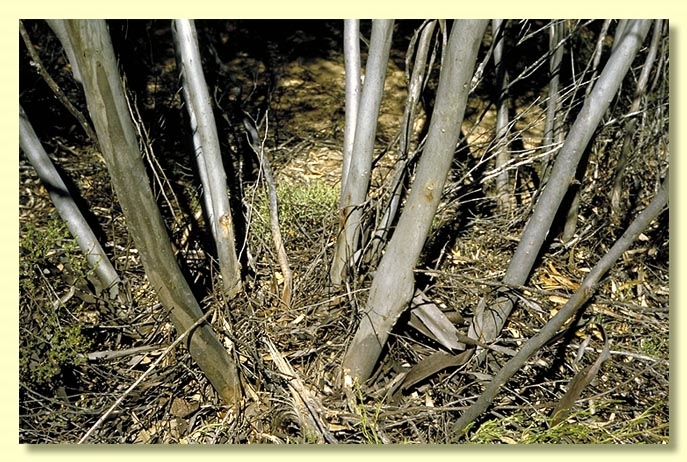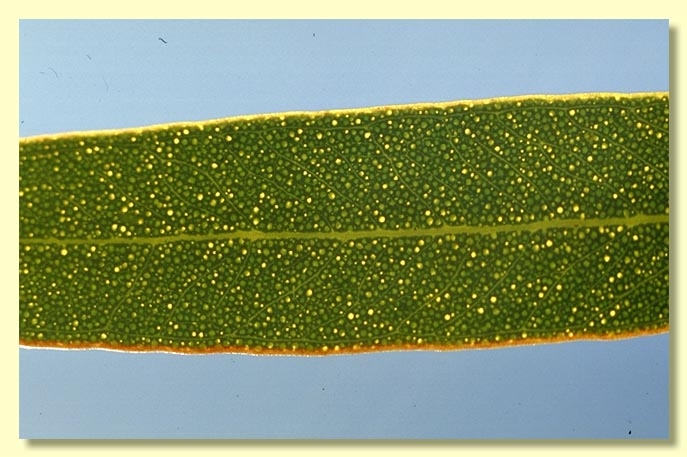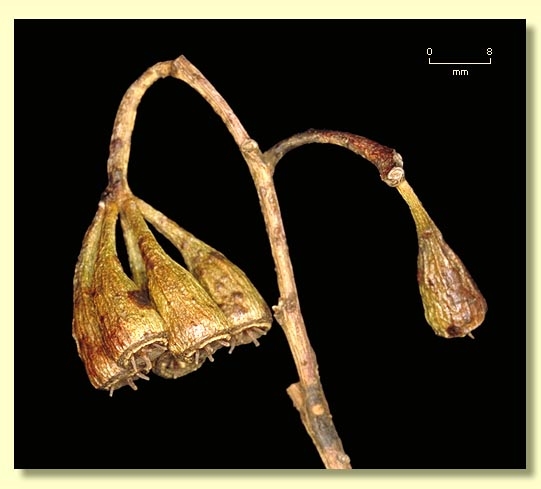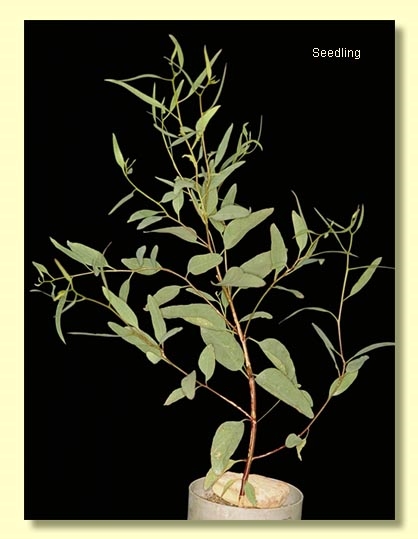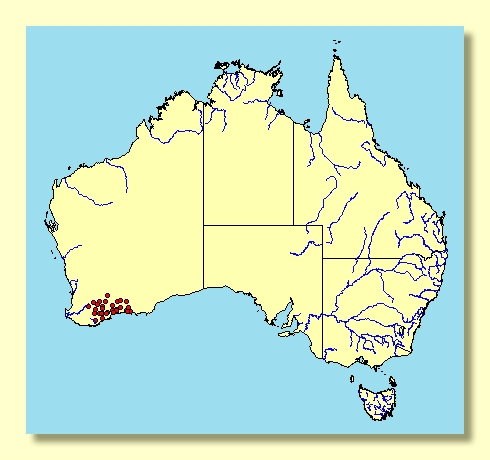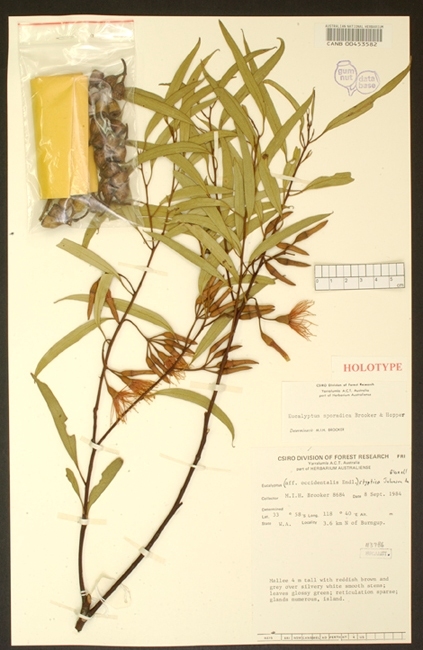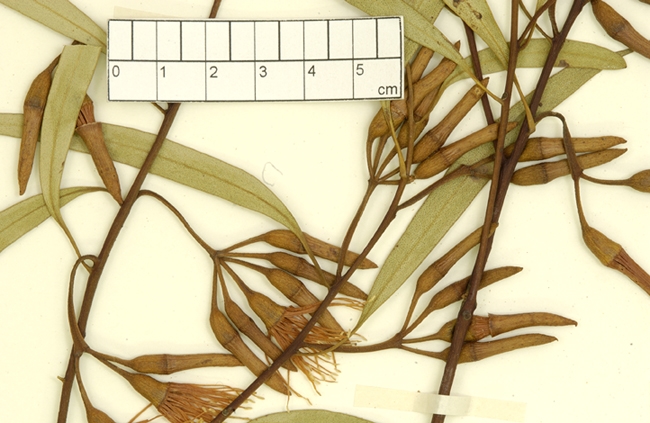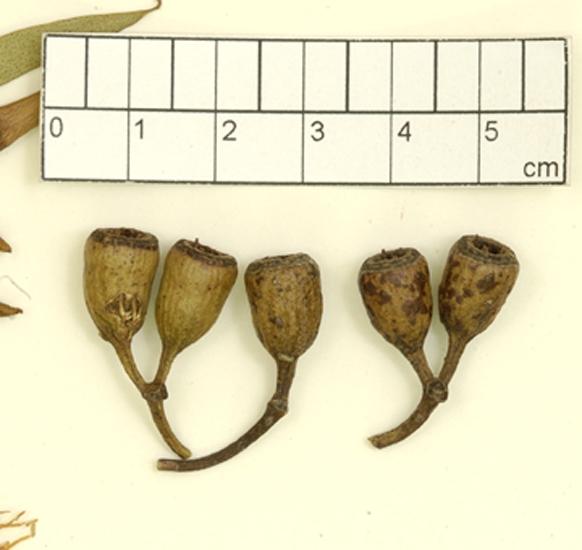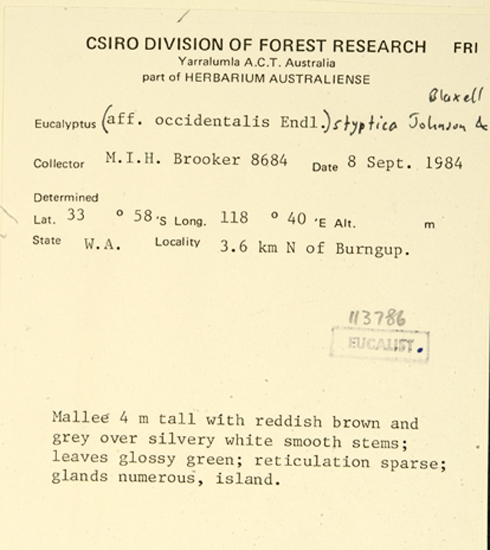Eucalyptus | Symphyomyrtus | Bisectae | Glandulosae | Erectae | Pedicellatae
Euclid - Online edition
Eucalyptus sporadica
Bark smooth throughout, silvery white to pinkish brown, grey-brown and pale coppery, shedding in ribbons.
Branchlets have oil glands in the pith.
Juvenile growth (coppice or field seedlings to 50 cm): stems rounded in cross-section; juvenile leaves always petiolate, alternate, ovate-lanceolate to elliptical, 3.5–7.5 cm long, 1.5–3 cm wide, blue-green.
Adult leaves alternate, petioles 0.7–2.5 cm long; blade lanceolate to narrowly so, sometimes falcate, 5–10 cm long, (0.5)0.8–1.8(2.2) cm wide, base tapering to petiole, margin entire, apex pointed, concolorous, green, only slightly glossy, side-veins at an acute or wider angle to midrib, reticulation sparse to moderate and clear, intramarginal vein remote from margin, oil glands irregular, numerous, island.
Inflorescence axillary unbranched, pendulous, peduncles flattened, narrow but widening apically, 1–4 cm long, buds 7, pedicellate (pedicels 0.1–1.2 cm long). Mature buds elongated and asymmetrically fusiform (1.3–2.8 cm long, 0.3–0.7 cm wide), scar present (outer operculum shed early), inner operculum horn-shaped, ca 2–3 times the length of the hypanthium, stamens erect, anthers oblong, versatile, dorsifixed, dehiscing by longitudinal slits, style long and straight, stigma blunt, locules 4(5), the placentae each with 4 vertical rows of ovules. Flowers usually lemon-yellow to greenish yellow.
Fruit pendulous, pedicellate (pedicels 0.3–1.2 cm long), obconical to almost cylindrical, 0.6–1.5 cm long, 0.7–1(1.2) cm wide, disc level at first then descending, valves 4(5), at rim level or exserted.
Seeds blackish brown, 1–2 mm long, ovoid to flattened-ovoid, dorsal surface shallowly and clearly reticulate, hilum ventral.
Cultivated seedlings (measured at node 10): cotyledons Y-shaped (bisected); stems rounded in cross-section; leaves always petiolate, opposite for 3 to 6 nodes then alternate, ovate-lanceolate, becoming narrower up stem, 3.5–6 cm long, 0.8–3 cm wide, dull, green.
Flowering has been recorded in January, March, June, July, August, September, October and November.
A mallee endemic to Western Australia, scattered through the south-eastern wheatbelt and adjacent subcoastal heath, from Peak Charles west to Tarin Rock and south to Fitzgerald River National Park. The bark is smooth and the adult leaves slightly glossy, green with some side-veins visible among the numerous oil glands.
Eucalyptus sporadica belongs in Eucalyptus subgenus Symphyomyrtus section Bisectae subsection Glandulosae because the buds have an operculum scar, cotyledons are bisected and branchlets have oil glands in the pith. Within this large subsection (ca 80 species) E. sporadica is closely related to a group of mallees and mallets (series Erectae subseries Pedicellatae) recognised by the glossy green leaf surface, leaves with many oil glands but not obscuring the secondary venation, peduncles long and flattened or terete, inflorescences spreading to pendulous and buds with a long operculum and erect stamens arising from a narrow staminophore.
Eucalyptus sporadica is closely related to the rough-barked mallee from the Hyden Scrub and southern goldfields, E. aspratilis, but differs in having more obconical (not cylindrical) fruit and smooth bark. The common southern tree of freshwater creeks, E. occidentalis, is also closely related but differs in its rough black trunk, campanulate fruit and buds in clusters of seven to 13. The rough-trunked tree of saline depressions, E. sargentii, has smaller buds and obconical fruit.
Species of the E. eremophila group, viz. E. eremophila, E. tenera, E. tephroclada, E. incerata and E. depauperata, have somewhat similar long slender buds but can always be distinguished by the leaves which are so crowded with oil glands that the venation is obscured.
Eucalyptus sporadica is one of the parents of the hybrid E. bennettiae. For further details see Notes on the other parent, E. lehmannii subsp. parallela.


